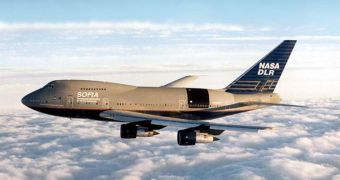The newly-completed SOFIA airborne telescope may hold the key to unlocking some of the mysteries our galaxy hides, such as for example how it was possible for millions of stars to develop in the presence of a supermassive black hole.
The Stratospheric Observatory for Infrared Astronomy (SOFIA) was developed by the American space agency in collaboration with researchers from the German Aerospace Center (DLR).
It is currently scheduled to fly at least 2,800 missions over the next two decades, which is the equivalent of about three to four flights per week.
The new telescope is housed aboard a heavily-modified Boeing 747SP jetliner. It is installed in the rear section on the plane, on a series of mechanisms that allow it to remain pointed at the same spot in the sky regardless of the maneuvers the plane has to make.
At this point, SOFIA is scheduled to make its first scientific observations within the next couple of month, considering that the airborne observatory has already seen first light, and that all flight tests have been passed with flying colors.
The Boeing aircraft has a maximum flight altitude of 40,000 feet, or roughly 13,760 meters. This will allow it to fly over clouds banks, providing excellent conditions for the telescope.
Running astronomical observations from the surface of the planet requires that some very specific conditions to be met, such as for example a clear sky.
This is why so many telescopes are currently placed in Chile's Atacama Desert. Precipitations here are extremely scarce, and the skies are always clear.
Building a large, ground-based telescope in an area located in temperate climate means that the facility will be unusable for half the time it's online.
Having an airborne observatory means that studies can be conducted from wherever experts want to.
Additionally, eliminating the cloud banks out of the picture allows for SOFIA to observe infrared wavelengths that would have otherwise been absorbed by the atmosphere.
Even though it took millions of dollars to build it, the telescope is still a lot cheaper than any space telescope that could have been constructed with similar capabilities.
“We will look at the galactic center for as long as we can. With SOFIA, we will be getting data that we really couldn't get any other way,” says Eric Becklin.
He is the chief science adviser for SOFIA, and a professor emeritus of physics and astronomy at the University of California in Los Angeles (UCLA).
“SOFIA gives us an opportunity to understand the physics of what happens there by studying it in detail. I believe we will do that well with SOFIA,” the expert concludes.

 14 DAY TRIAL //
14 DAY TRIAL //